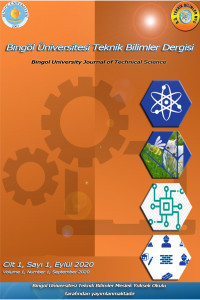Bingöl İlçelerinden Elde Edilen Süzme Çiçek Ballarında İnvert Şeker Miktarının Belirlenmesi
Bal, İnvert şeker, Bingöl, Türk Gıda Kodeksi Bal Tebliği
Determination of Invert Sugar Amount in Filtered Blossom Honey Obtained from Bingöl Districts
Honey, Invert sugar, Bingöl, Turkish Food Codex Honey Communiqué,
___
- Kekeçoğlu M, Gürcan, EK, Soysal Mİ. Türkiye arı yetiştiriciliğinin bal üretimi bakımından durumu. Tekirdağ Ziraat Fakültesi Dergisi. 2007; 4(2), 227-236.
- Karadal F, Yıldırım Y. Balın kalite nitelikleri, beslenme ve sağlık açısından önemi. Erciyes Üniversitesi Veteriner Fakültesi Dergisi. 2012; 9.3.
- Silva PM, Gauche C, Gonzaga LV, Costa ACO, Fett R. Honey: Chemical composition, stability and authenticity. Food chemistry. 2016; 196, 309-323.
- Mutlu C, Erbaş M, ve Arslan Tontul S. Bal ve Diğer Arı Ürünlerinin Bazı Özellikleri ve İnsan Sağlığı Üzerine Etkileri. Akademik Gıda. 2017; 15(1), 75–75. https://doi.org/10.24323/akademik-gida.306074
- Anonim 2021. FAO Stats, Stat. Reports. https://www.fao.org/faostat/en/#data/QCL Erişim tarihi: 21.04.2023
- Şahinler N. Arı Ürünleri ve İnsan Sağlığı Açı-sından Önemi. Mustafa Kemal Üniversitesi Ziraat Fakültesi Dergisi. 2000; 5 (1-2) 139-148.
- Kukurova K, Karovıèová J, Kohajdova Z, Bilikova K. Authentication of honey by multivariate analysis of its physico--chemical parameters. Journal of Food & Nutrition Research. 2008; 47(4).
- Kamal MA, Klein P. Determination of sugars in honey by liquid chromatography. Saudi journal of biological sciences. 2011; 18(1), 17-21.
- Cengiz MM, Tosun M, ve Topal M. Determination of the physicochemical properties and 13C/12C isotope ratios of some honeys from the northeast Anatolia region of Turkey. Journal of Food Composition and Analysis. 2018; 39–44. https://doi.org/10.1016/j.jfca.2018.02.007
- Tetik İ. Yerli, tabii, süzme ballarımızın besleyici değeri ve gıda tüzüğü yönünden kimyasal bileşimleri üzerine araştırmalar. Yargıçoğlu Matbaası. 1968
- Muller HG, Tobin G. Nutrition and food processing. Croom Helm. 1980
- Güzel N, Bahçeci KS. Çorum Yöresi̇ Ballarinin Bazi Ki̇myasal Kali̇te Parametreleri̇nin Değerlendi̇ri̇lmesi̇. Gıda. 2020; 45(2), 230-241.
- Juan-Borrás M, Domenech E, Hellebrandova M, Escriche I. Effect of country origin on physicochemical, sugar and volatile composition of acacia, sunflower and tilia honeys. Food Research International. 2014; 60, 86-94.
- Anonim 2020. Türk Gıda Kodeksi Bal Tebliği, Tarım ve Orman Bakanlığı, Ankara, 2020/7.
- Anonim 2010. BAL. Türk Standartları Enstitüsü, Ankara, TS 3036.
- Merin U, Berstein S, Rosenthal I. A parameter for quality of honey. Food Chemistry. 1998; 63: 241–242.
- Al-Khalifa AS, Al-Arify IA. Physicochemical characteristics and pollen spectrum of some Saudi honeys. Food Chemistry. 1999; 67: 21–25.
- Yılmaz H. Composition of honeys collected from easternand sour the astern Anatolia and effect of storage on HMF content and diastase activitiy. J. AgricFor. 2000; 25: 347349.
- Şahinler N, Şahinler S, Gül A. Hatay yöresi ballarının bileşimi ve biyokimyasal analizi. Mustafa Kemal Üniversitesi Ziraat Fakültesi Dergisi. 2001; 6 (1–2): 93–108.
- Ünal C, Küplülü Ö. Chemical quality of strained honey consumed in Ankara. Ankara Ziraat Fak.Derg. 2001; 6: 25-30.
- Ouchemoukh S, Louaileche H, Schweitzer P. Physicochemical characteristics and pollen spectrum of some Algerian honeys. Food Control. 2007; 18: 52–58.
- Akbulut M, Özcan MM, Çoklar H. Evaluation of antioxidant activity, phenolic, mineral contents and some physicochemical properties of several pine honeys collected from Western Anatolia. International Journal of Food Sciences and Nutrition. 2009; 60 (7): 577–589.
- Kahraman T, Büyükünal SK, Vural A, Altunatmaz SS. Physicochemical properties in honey from different regions of Turkey. Food Chemistry. 2010;123: 41–44.
- Saxena S, Gautam S, Sharma A. Physical, biochemical and antioxidant properties of some Indian honeys. Food Chemistry. 2010; 118: 391–397.
- Derebaşı E, Bulut G, Col M, Güney F, Yaşar N, Ertürk Ö. Physicochemical and Residue Analysis of Honey from Black Sea Region of Turkey. Fresenius Environ Bull. 2014; 23(1):10-17.
- Yayın Aralığı: Yılda 2 Sayı
- Başlangıç: 2020
- Yayıncı: Bingöl Üniversitesi
Başak ZENGİN, Hasan POLAT, Uğur Eren YURTCAN
Hazır Beton Santralinin Karbon Emisyonlarının Belirlenmesi
SERİ MANİPÜLATÖRLERİN DÖNÜŞÜM MATRİSLERİNİN ELDE EDİLMESİNİN KOLAY YOLLARI
Bingöl İlçelerinden Elde Edilen Süzme Çiçek Ballarında İnvert Şeker Miktarının Belirlenmesi
Bazı Minerallerin Radyasyon Zırhlama Kapasitelerinin Araştırılması
